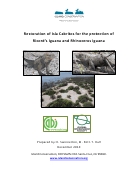Isla Cabritos and Lago Enriquillo National Park is an internationally recognized site important for its unique and abundant biodiversity. Isla Cabritos supports two populations of threatened Cyclura rock iguanas, the only viable population of American Crocodile in the Dominican Republic, and the lake supports a diverse array of waterbirds and land birds, including Caribbean Flamingo and West Indian Whistling-duck.
The integrity of Isla Cabritos as a protected area continues to be threatened by the impacts of introduced non-native mammals: feral burros, feral cattle, and feral cats. Burros and cattle cause habitat degradation through over-grazing and trampling, disturb iguana and crocodile nests through digging, and compete for food with iguanas and other native herbivorous species. Feral cats are significant predators of Cyclura iguanas, causing high mortality of adults and juveniles, resulting in severe population declines. In addition the rising levels of the surrounding lake is rising leading to further habitat loss.
The permanent removal of feral burros, cattle, and feral cats has been identified as a priority conservation action to protect the two species of iguana and promote habitat restoration on the island. In this document, we present options and recommendations to eradicate, completely, these three feral mammals from Isla Cabritos. Invasive species eradication is a commonly used conservation tool with which to restore biodiversity threatened by introduced mammals. Invasive species eradication from Isla Cabritos is not technically difficult, and the parameters fall well within the boundaries of other successful projects.
The result of this action will be to safeguard a significant proportion of the critically endangered Ricord’s Iguana population, to protect the island population of Rhinoceros Iguana, and to restore habitat for iguanas and other native wildlife on the island.
Community involvement is considered paramount to the long-term sustainability of the project, and to reduce the risk of re-invasion and reintroduction of domestic and feral animals from the surrounding area. Local environmental organizations already working within the area should be engaged to ensure that the conservation gains from invasive species removal are maintained.
Full Article>>>IAS eradication feasibility plan Cabritio. pdf
